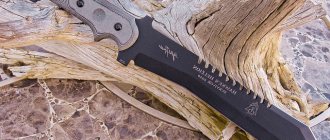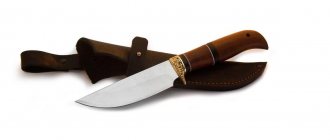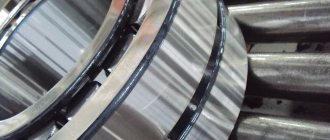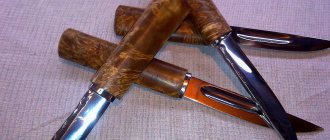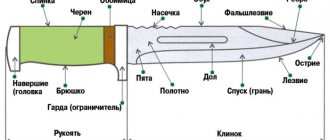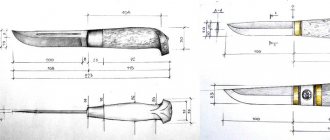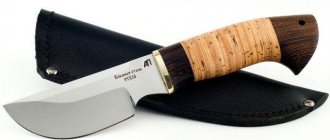Among connoisseurs of edged weapons, knives made of Damascus steel are especially popular. There are several misconceptions and myths surrounding this material. Here are some of them: the technology for creating Damascus has long been lost, a blade made from this metal does not need to be sharpened, Damascus blades cut steel and down pillows equally well, and Damascus and damask steel are the same thing.
In fact, like other weapons, Damascus steel knives require regular sharpening and careful care. The technology for producing such blades has been preserved, so now there are various models on sale - kitchen, hunting, tourist and others. Damascus and damask steel are far from the same thing.
Damascus and damask steel: history of origin and distribution across the planet
Damascus knives have been used for hunting since ancient times. They were used for cutting game, skinning dead animals, and in everyday life as a kitchen tool.
Such weapons were considered elite. It was valued for the following qualities:
- durability;
- excellent cutting qualities;
- the beauty of the material and patterns;
- strength, but at the same time flexibility of the blade.
The first mention in history of Damascus steel is associated with the time of Alexander the Great’s campaign in India. Then he clashed in battle with the army of the local king Porus. He was wearing a protective shell made of this alloy, on which Greek swords did not leave a scratch. The swords of Indian warriors were made from the same material.
During the Crusades, European warriors were amazed by the sharpness of Arab sabers made of Damascus steel. The crusading knights happily bought such weapons and brought them home as trophies.
There are three theories about the origin of the name of Damascus weapon:
- Damascus means “water” in Arabic. In documents of that time it was described as a blade, on the surface of which there is a pattern in the form of a rippling surface of water.
- This steel was produced in Damascus. However, this ancient city was more of a major trading city, rather than a weapons city. Therefore, most likely, it was only brought here from outside.
- Supporters of the latter refer to a certain weapons maker Damascus, after whom this material was named.
The manufacturing technology has spread around the world and received various names.
Mentions of damask blades are found in Aristotle, during the times of Ancient Greece. It is believed that Damascus was invented as a cheap analogue of damask steel.
The cutting qualities of both materials are approximately the same, but damask steel is somewhat stronger.
It should be noted that the secret of damask steel was lost. The second discovery of the secret of damask steel is associated with the name of Pavel Anosov.
He made cast damask steel in 1837, although he knew that this alloy had been produced in Russia even earlier, in the 16th and 17th centuries. (under the name “cold steel” or “haraluzhnaya” steel or “Russian damask steel”).
But the Russian gunsmith did not leave precise instructions for creating damask blades. And it remains unknown whether the domestic metallurgist reproduced the ancient manufacturing method, or created a new one.
What is real damascus and damask steel
For damask steel, knife blanks are obtained by heating, twisting and re-forging several hundred layers of steel. The materials alternate according to the hard layer-soft layer principle. One layer is carefully placed on top of the other, and then the entire package is reforged. The output is a blade of several hundred layers.
To ensure that the plates fit tightly to each other, they are pulled together with rods. Forge welding of metal layers is carried out until a blade of the required quality is obtained. Forging must be accurate and of high quality, defects in the form of slag are not allowed, the metal is carefully forged.
The pattern should be clearly visible across the entire blade.
It follows the structure of the metal: the more different layers were used, the finer the patterns on the blade. Moreover, they are never repeated. Plus, it is the multilayer composition of the blade that ultimately gives the unique characteristics of a weapon made of Damascus steel - a sharp and durable blade, a unique appearance, etc.
Before you start sharpening your blade, you need to put it in order. Examine it carefully. The sharpening angle of the knife is selected depending on the purpose of its use. It is the task of the blade that determines at what angle you need to work with the abrasive stone.
Bulat is, according to P. Anosov himself, a high-carbon steel. No special impurities are added to it. On the contrary, the main thing is clean raw materials. You will need to combine iron and carbon, after which you need to:
- Heat to desired temperature.
- Cool the resulting alloy until the metal crystallizes.
To produce damask steel, two materials are melted - high and low carbon. The melting point of the latter is somewhat lower. When cooled, the surface becomes coated with carbon, which makes the blade unusually strong.
As a result, the differences in production technology are as follows:
- Damascus is made by layering and forging hard and soft layers of metal.
- Bulat is a cast alloy, the creation of which is based on temperature changes.
Forging Damascus in a forge
The production of Damascus can occur in several different ways; we produce the so-called ''welded Damascus''. This technology involves the selection and welding of workpieces (hence the name welding) from various grades of steel, soft and hard, which allows achieving the necessary characteristics for good cutting properties of the blade.
In the photo (from left to right): assembling and welding a package of steels, twisting an unforged package, forging a package of steels with a hammer.
Damascus is not a metal found in nature in its pure form, but consists of a package of steels selected by us as a result of a large number of tests. To create it, we use a package of four steel grades (ShKh-15, KhVG, U8A, steel-3), each of which is necessary to impart the necessary cutting properties to the final product.
Let's move on to the technological process itself in more detail. After the workpiece has been prepared from a package of steels, it must be heated to a bright red color, after which you can proceed directly to forging. The forging process is repeated three times, the thickness of the forged strip in the first two stages does not have clear regulation, and in the third final stage it is made as close as possible to the thickness of the butt of the final product, in order to avoid unnecessary consumption of metal and lengthening the processing process.
Next, the workpiece is given a rectangular shape for the next technological process - twisting. The fragment directly with twisting was not included in the video, but there is nothing particularly complicated here, the hot workpiece is twisted in a spiral, for as many revolutions as can be achieved before the metal hardens - as a result of which the shape of the workpiece changes from rectangular to cylindrical ( You can see the unforging of the twist at the 10th minute of the video). The texture of the pattern on the blade depends on the number of twists.
In addition, I would like to draw your attention to such a moment of the technological process as borax sprinkling (white powder), which is used during forging of the workpiece after twisting to draw out slag and scale, which avoids the appearance of fistulas and lack of penetration. After this, a strip of metal is obtained from which the blades themselves will be made. Now we move on to the workshop, where a knife will be made from the strip, and finally, a few more photos from the forge.
Knives and other edged weapons made of Damascus steel
A Damascus steel knife should fit easily in your hand. Since it is used as a cutting tool, the blade is sharpened only on one side. On the other hand, there is an unsharpened part a couple of millimeters thick. The crosshair is either absent or small, but the grip usually has small rests for the index finger.
Any materials are used to make the handle. Natural ones include various wood or animal horns. Typically, a handle made of natural materials is impregnated with special oils, which help protect it from moisture and dirt. Some models have a plastic handle, which is cheaper and much more convenient in everyday conditions - it does not slip and lies securely in the hand.
The sheath can be made from any material. Usually made of genuine leather. The main thing is that the knife is reliably protected from the external environment. The advantages of Damascus knives are as follows:
- light weight;
- beautiful appearance, unique patterns;
- good cutting properties;
- With proper use and care, the knife will last for many years.
These knives have several disadvantages:
- They are quite expensive and not available to the general public. A high-quality knife, made to order by a master, costs from 50,000 Russian rubles.
- The knife is used as a cutting tool. Since it has a small blade, it will not be able to cut branches or denser materials (although edged weapons - axes, swords, etc. - can easily cope with this task).
- Like all knives, the blade needs regular sharpening.
- The steel from which the knife is made reacts poorly to a number of alkalis and acids, and is therefore vulnerable to corrosion.
Making a knife from Damascus steel
You can make a Damascus knife with your own hands. To do this, you need to familiarize yourself with thematic photos, videos of how such blanks are made, and also select all the necessary devices and consumables.
Materials and tools
To create a knife, you need to prepare the following materials:
- plates made of carbon steel of two grades (the higher the carbon content, the better the blades);
- borax (sold in hardware departments);
- rod for welding a knife blank;
- quick-drying epoxy glue;
- brass rivets;
- ferric chloride;
- vegetable oil for steel hardening;
- wood for the handle.
You will also need a number of tools for the job. First of all, you need an anvil. It is better to equip a real anvil, but a piece of rail or a large metal sledgehammer will do. You also need a heavy hammer (1-1.5 kg in weight) and a forge capable of maintaining a high temperature. Other required equipment:
- welding for welding plates, securing reinforcement (wire can be used);
- a belt-type grinder (if you don’t have one, a file will do, but the work will take a long time);
- oven, other heating device;
- drill or drilling machine;
- vice.
Assembling the knife blank
First, you need to create blanks and cut steel plates to the required length. Beginners are advised to make small blanks, since it will be more difficult to create a knife from large ones. Welding areas must be cleaned of scale and corrosion, and plates must be laid with alternating metals by grade. There can be 3-7 or more plates in total. Then the following actions are performed:
- align the plates;
- grab them by welding;
- weld a piece of reinforcement to the workpieces as a handle;
- Instead of such a handle, you can use ordinary pliers.
First forging of a knife stack
In addition to a real forge, you can use a homemade one made from an empty gas cylinder. The inside of the cylinder should be lined with a layer of kaolin wool and fire-resistant cement. You can heat up any forge using a gas burner. If it is small, then heating occurs quickly. Afterwards the actions will be as follows:
- put the knife blank into the forge;
- heat the future knife until red-cherry color (at moderate heat);
- sprinkle the workpiece with borax so that it melts and “saturates” the plates (this is required to remove rust, prevent oxidation, and improve the cleanliness of the steel);
- clean the protruding scale, repeat heating again after a while;
- if necessary, duplicate all actions.
Next, the workpiece is heated to a higher temperature - forging (about 1300 degrees), and the metal becomes bright yellow. They begin to forge the plates together with blows of medium power. Afterwards, the knife blank is pulled out for bending.
Bending the workpiece
A stack of plates must be forged to a length equal to two lengths of the future knife. It must be stretched evenly so that the thickness remains approximately the same over the entire area of the product. Using a chisel, a transverse recess is made in the center, slightly not reaching the bottom edge (not the entire thickness). Then the knife blank must be bent in half along the mark made, turned over, and forged along the length. The halves should match well at the edges.
After bending, heat up the future knife again, forge it, sprinkle with borax, and let cool. Then stretch and bend again. The goal is to get more layers to create an original drawing. To calculate the number of layers sufficient for a particular knife, you can use the formula:
initial number of steel sheets * 2 * number of bends (usually 3-4).
At the end of the work, place the knife blank in the groove of the anvil, twist it, then forge it again to a rectangular shape. Before twisting, it should be pierced in the corners to give it some roundness and to prevent the appearance of impurities and inclusions from folds. The temperature in the forge must be consistently high, otherwise the quality of the steel will decrease and the layers will not be firmly bonded to each other.
Model and rough profile formation
The appearance of the knife must be imagined in advance. Which profile is best to choose can be found on the Internet. According to the drawing, you need to start forging from the workpiece; at first it will be rough. It is important to try and make the work finer so that sanding is less difficult. When heated, metal can be “sculpted” like plasticine, so you need to give the product a beautiful appearance.
Profile grinding
If you don’t have a grinder or a special machine, use a file and a grinder. The product must be smooth, even, and shiny. Then you should drill a hole for the handle, and also sharpen the knife a little (not completely, otherwise it will warp when heated).
Ready profile
Finish the workpiece with a 400-grit file. Using a fine grain will help give the workpiece a finally smooth look. Also at this stage you need to prepare wooden strips for the handle (2 pieces) and rivets for attaching them.
Last hardening
This point in knife making is considered the most dangerous and difficult. Tempering will either make the blade perfect or warp it. You need to work very carefully so as not to deform the blade. Before starting all actions, the product is normalized to eliminate excessive stress on the steel and reduce the risk of warping. To do this, you need to heat the blade more than its critical temperature. A magnet will be needed to determine the time when the metal stops being magnetized - this will be the point at which the desired temperature is reached.
After heating, the workpiece must be cooled in air. You will have to repeat the procedure 3-5 times. As it cools, it will be possible to evaluate the resulting steel pattern. Next you need to proceed with the most responsible actions:
- once again heat the workpiece above the critical temperature;
- remove the blade from the forge, quickly place it, tip first, into warm vegetable oil (it must be evenly heated in advance);
- water cannot be used, it will ruin high-carbon steel;
- Carefully place the product on a flat surface (it will be fragile, like glass).
Metal release
The tempering process hardens the knife blade to increase service life. This is done by heating the blade in the oven at a temperature of about +205 degrees for 1-1.5 hours.
Etching
At this stage you will need ferric chloride. It is made according to the manufacturer's instructions, then the finished blade is placed in the solution. Usually 3 parts of water are taken, 1 part of ferric chloride, the exposure time is 3-5 minutes.
Handle and sharpening
For the handle, you can take any wood - from the simplest birch to expensive types of wood. Cherry and alder work well. The workpiece is ground and attached to the handle with epoxy glue and brass rivets. At the end of the work, the wood is sanded and impregnated with linseed oil or special stains.
It is better to sharpen the knife right away. It is worth learning in advance how to sharpen a product correctly so that problems do not arise in the future. Since soft layers alternate with hard ones, bending one layer onto another must be avoided during the sharpening process. First, inspect the blade for chips and nicks: they will need to be cut down. Then you can use abrasive materials to evenly remove layers. First, coarser grains are used, then finer grains.
Tips for sharpening the product:
- the knife cannot be sharpened using the transverse method, it may be damaged;
- sharpening is done diagonally, starting movements by hand;
- processing is carried out with minimal pressure;
- At the end of the work, wipe the base with a napkin (you can also apply lemon zest to extend the life of the knife).
Household and travel knives made of Damascus steel
Kitchen knives are suitable for cutting meat, fish and poultry, fruits and vegetables. This is a reliable cutting tool for everyday use. For meat and poultry, a fillet knife with a wide blade is used.
Tourist models are valued primarily for their durability. Especially among fans of extreme tourism. Plus, damask steel does not require frequent sharpening. Usually such a knife has a small blade. It is used during hunting or fishing.
Fishing knives made of Damascus steel have a small blade designed for processing fish and working with nets.
It is convenient to use folding knives made of Damascus steel on a hike - they are ergonomic, safe when moving, do not require a sheath, they can be put in a pocket and quickly pulled out. The only drawback is reliability. Due to the presence of the mechanism, the design becomes more complicated.
And in the wild, weapons that are simpler are valued. After all, the more mechanical components there are, the more likely it is that one of these components will fail at the most inopportune moment.
Modern survival knives have a rather complex design, but this is a special type. After all, they are designed for one-time use, only in extreme cases; the rest of the time, a survival knife should lie and wait in the wings.
How to make a small knife from Damascus steel (without a mechanical hammer)
Translated by SaorY for mozgochiny.ru
Greetings to all brain crafters ! After almost a year of “communication” with a hammer and an anvil, I finally acquired the necessary experience and tools to create forged crafts , such as the small “Damascus” knife from this brain article .
And I started, by the way, with a small sledgehammer as an anvil, which I hit with a small hammer.
Now we will talk about creating a small, forged, not carved, knife with your own hands using a homemade forge, anvil, hammer and determination. I don’t pretend to be a professional, and this is certainly not the only way to obtain welded Damascus; this is the story of how I managed to make it.
Damascus steel today is called welded Damascus, obtained from welded metal plates of various brainsteels , subsequently forged and twisted. It's like molding different colors of plasticine together and twisting it to create a wavy pattern.
After forging, such a workpiece is subjected to etching, in which the dissimilar metals of the workpiece are eroded unevenly, thereby creating a beautiful contrast.
The original Damascus steel is obtained in a different, very specific way (although it looks similar to modern Damascus), and few people know how to create it; this fact has given Damascus a reputation as a metal supposedly endowed with magical powers.
And the reason for this “power”, similar to samurai swords, is a process that makes it possible to obtain a more homogeneous, and therefore with the desired qualities, steel, which cannot be achieved in other ways, and makes it possible to include low-quality and high/low carbon steel in the workpiece. Which results in a much better quality blade.
!!! ATTENTION!! A knife can be dangerous, please do not give it to people with mental disorders!!!
Step 10: Tempering the Metal
Tempering is the process of imparting some hardness to a blade to increase its life and strength. This is achieved by heating the blade at a certain controlled temperature. my brainwork in the oven for an hour at a temperature of 205 degrees Celsius. “Bake” until “ready” appears on the display.
Step 11: Etching
I apologize in advance for the lack of photos of this and the next steps, but the process is quite simple.
the instructions supplied with it , and then the blade is kept in it for as long as indicated in the same instructions.
In my case, it's 3 parts water to 1 part ferric chloride, and let it sit for 3-5 minutes. The process is truly exciting, and the result looks like Batman's knife.
Step 12: Handle and Sharpening
Again, there are many techniques and instructions on how to make a knife handle and sharpen it, so I’ll do without the brainy details .
Let me just say that for my craft I chose cherry dies, which I glued to the handle of the knife using epoxy glue and secured with two brass rivets.
I sanded it with 400 grit and coated it with linseed oil.
For sharpening, I do not use any special, labor-intensive method, but mostly use a regular whetstone.
Do damascus and damask steel rust?
Damascus and damask steel are susceptible to rust. It is removed using a rag, which is soaked in gun oil (alkaline or neutral type). But you shouldn’t use an abrasive for cleaning: the polished blade can be scratched. You can use hard rubber or special solutions.
No need to remove it unnecessarily. After use, the knife should be thoroughly cleaned, wiped, lubricated with oil or grease, and then stored in a dry place. If it is stored or used in an environment with high humidity, you need to wipe the blade with regular Vaseline.
Leather sheaths can also be impregnated with special products designed specifically for leather care.
However, there are also stainless steel models of knives made of Damascus steel and damask steel. Thanks to the use of special additives, the blade is protected from rust, while maintaining sharpness and strength. However, stainless steel cannot maintain an edge for a long time, for this reason it is not very valued by true connoisseurs of Damascus knives.
Folding knives are more susceptible to corrosion, so they should be made only from stainless materials. It is desirable that it have a plastic handle. However, the technology for producing high-alloy Damascus is quite complex, which is why the cost of such knives is much higher than conventional models.
Modern manufacturers of damask steel knives
Both foreign and domestic manufacturers are engaged in the production of damask knives. They can be divided into three conditional groups:
- Individuals producing knives in “artisanal conditions”. The quality and appearance of the product will be worse, but it will cost much less.
- Trademarks engaged in mass production and sale. They are of good quality, and the price ranges from 3,000 to 10,000 Russian rubles. Most people buy industrial knives.
- Masters specializing in the manufacture of damask knives. They sell products, as a rule, at exhibitions, providing complete information to buyers. For example, famous blacksmiths who create weapons from damask steel are I. Pampukha, S. Baranov and A. Biryukov. The price reaches tens of thousands of rubles, but such a weapon will last for many years, becoming a family heirloom.
Currently, knives made of damask steel and Damascus steel from Zlatoust and Kizlyar, as well as from smaller manufacturers, are widespread in Russia. These mass products are much worse in quality than the products of craftsmen, but they fully satisfy the requirements of the mass consumer, and they are affordable.
You can purchase them both in hunting and online stores. It is more convenient for hunters and fishermen to use a knife with a hook blade to cut up carcasses.
Damascus, damask steel and modernity
Despite the emergence of new alloys and materials, knives made of Damascus steel and damask steel still remain the most desirable. Both have the same cutting properties, but damask steel is stronger, which is why it costs more.
Their main competitor in the market is ceramic knives.
They have almost identical cutting properties, but damask and Damascus knives are more reliable and elegant.
In the manufacture of Damascus, various alloys, advanced heating, forging and sharpening technologies are used. Thanks to this, original models are created with unique carvings and patterns.
When purchasing a knife, you should also take into account the legal requirements in relation to edged weapons. The knife must have a certificate stating that it is not a bladed weapon, or can only be distributed under a license to own a civilian weapon.
Bulat and Damascus
Drawing of Damascus steel on a metal cut:
The term Damascus steel appeared relatively recently. A similar name for forged products began to appear in various sources in the middle of the 19th century. Before this, the name “Gurda” was more often used, as the creations of blacksmiths from the Caucasus and Mesopotamia were called. There they began to forge products from a mixture of alloys, achieving an unusual pattern on the surface of the blades.
Damask steel, as historical research shows, came from India. History museums have preserved samples of weapons that used alloy steel castings. Most often they contain chromium, the concentration of which can reach up to 14%.
However, damask steel production is designed only for individual production. Therefore, the technology is quite expensive. The master spends a lot of time to make a specific sample. If there is a conversation about mass production, then do not count on complex technology.
Metallurgist Pavel Petrovich Anosov studied production technology and created industrial technologies. The results of his work are present in all textbooks on metal science and blacksmithing.
Modern damask steel in products - a replica of the HP-40 knife in a modern design, made to order:
During the Great Patriotic War, the plant produced army knives and sabers for cavalry. Quite a lot of weapons have since been sold on various Internet resources. Modern blacksmiths produce remakes (this is the name for products that are made in the image and likeness of ancient samples). Several hundred workshops offer copies that are difficult to distinguish from the original.
Scout knife NR-40, made in 1942 - more than 7 million copies were produced:
Judging by the number of offers and prices, we can conclude that individual goods are in stable demand. The production of products from damask steel and Damascus steel can be quite an interesting and profitable business.
Modern knife HP-40, made according to samples from the period of the Great Patriotic War:
Experts see the difference between damask steel and Damascus steel in the raw materials:
- Damask steel is an alloy that contains a significant amount of alloying elements; during subsequent forging processing, platinum is connected using the forge welding method, which gives the product a complex of new properties.
- Damascus is a mechanical connection of metal blanks that differ in their properties. Forging up to several dozen layers is performed.
Prospects for Damascus knives
Damascus knives are a popular weapon among both beginners and professional hunters. And the unique appearance of steel attracts collectors of bladed weapons.
The combination of beauty, functionality and reliability make them a popular tool.
Various models are created from this steel. Damascus steel folding knives are popular. Thin blades and cleavers are better suited for the kitchen. Therefore, such a tool will not have problems with buyers.
Finding real Damascus steel is another matter. Since such knives have acquired cult status, many sell low-quality goods under the guise of popular material. This is what Arab traders did before, in the Middle Ages, and this is what happens now.
